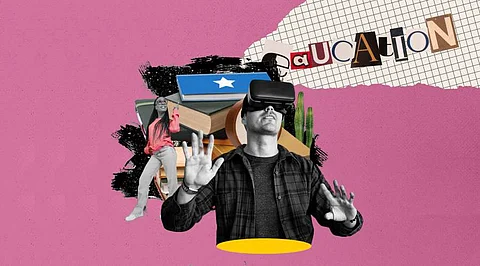

In recent years, technological advancements have transformed various industries, and the field of education is no exception. Augmented Reality (AR) has emerged as a groundbreaking tool that is changing the reality of education. By blending the digital and physical worlds, AR offers immersive learning experiences that enhance student engagement, comprehension, and retention.
AR technology enables students to visualize complex concepts and abstract ideas by overlaying digital content in the real world. For instance, anatomy lessons can be brought to life through 3D models of human organs that students can explore and interact with. This interactive approach deepens their understanding and enables them to grasp spatial relationships and functions in a way that traditional textbooks cannot match.
Furthermore, AR simulations provide students with hands-on experiences that were once limited to controlled environments. From chemistry experiments to physics simulations, students can conduct virtual experiments, manipulate variables, and observe the outcomes in real time. These immersive experiences foster critical thinking, problem-solving skills, and scientific inquiry.
One of the significant advantages of AR in education is its ability to cater to individual learning needs. AR applications can adapt to each student's pace and learning style, providing personalized content and guidance. Whether it's interactive quizzes, adaptive exercises, or tailored feedback, AR can customize the learning journey for each student, maximizing their potential for academic growth.
AR also facilitates self-paced learning, allowing students to revisit content as many times as needed. This feature is particularly valuable for students who require additional support or those aiming to challenge themselves further. By empowering students to take control of their learning, AR promotes autonomy, self-motivation, and a deeper sense of ownership in the educational process.
AR bridges the gap between the classroom and the real world by contextualizing educational content. Whether it's exploring historical landmarks, examining geological formations, or understanding cultural heritage, AR enables students to explore these subjects in their authentic environments. By layering digital information onto physical locations, AR offers experiential learning opportunities that ignite curiosity and foster a deeper connection with the material.
In addition, AR can revolutionize field trips by providing virtual tours of inaccessible places or historical periods. Students can travel back in time, witness historical events, and interact with virtual characters, bringing history to life in a way that transcends traditional textbooks. This immersive and interactive approach fuels engagement and retention, making learning memorable and impactful.
AR promotes collaboration and peer-to-peer learning by enabling students to interact and share information in real-time. Through AR platforms, students can collaborate on projects, solve problems together, and exchange ideas, regardless of their physical location. This fosters teamwork, communication skills, and cross-cultural understanding, preparing students for the collaborative nature of the modern workforce.
Furthermore, AR facilitates seamless teacher-student communication. Educators can provide real-time feedback, guide students through challenges, and offer personalized assistance remotely. This not only enhances the learning experience but also extends educational opportunities to students who may have limited access to resources or specialized expertise.
Augmented Reality is transforming the reality of education by revolutionizing how students learn, engage, and experience the world around them. By harnessing the power of AR, educators can create immersive, personalized, and experiential learning environments that inspire curiosity, foster critical thinking, and promote collaboration. As technology continues to advance, AR holds the potential to reshape education, empowering students to become active learners and preparing them for the challenges of the future.
Join our WhatsApp Channel to get the latest news, exclusives and videos on WhatsApp
_____________
Disclaimer: Analytics Insight does not provide financial advice or guidance. Also note that the cryptocurrencies mentioned/listed on the website could potentially be scams, i.e. designed to induce you to invest financial resources that may be lost forever and not be recoverable once investments are made. You are responsible for conducting your own research (DYOR) before making any investments. Read more here.
